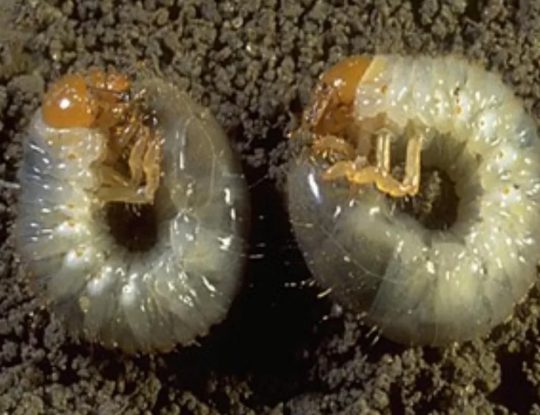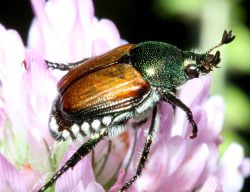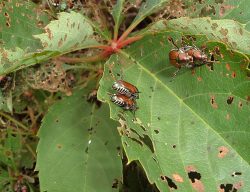Overview
Japanese beetles undergo complete metamorphosis, starting as grubs in your lawn and developing into round, metallic- sheened, hard bodied beetles. These hungry beetles enjoy a wide variety of plants and can cause some serious damage at both their larval and adult stages if they are left to flourish unchecked.
Grubs
Description/ Identification
- White larvae that feed on the roots of grasses
- Creamy white body with a dark head and the legs on the thorax are well developed
- Grubs thrive in short, well irrigated lawns
Damage
- Japanese beetle larvae primarily feed on grass roots
Prevention/ Treatment Options
- Keep your lawn mowed at a taller height
- Adjust your watering system allowing for your turf to dry between waterings (this will also reduce a variety of fungal issues and make your lawn more heat resilient!)
- Attract beneficial insects like Tiphia wasps that help control Japanese beetle Grub population In routinely mowed lawns
- Use pest control products like GrubEx or Milky spore (both must be applied in the late spring or early summer, typically May through Mid July in Fort Collins)

Image credit: David Shetlar, Ohio State University

Image credit: M.G. Klein, USDA Agricultural Research Service, Bugwood.org
Adult
Description/ Identification
- Measure about ½” in length.
- Generally metallic green with coppery brown wing covers
Damage
- Japanese beetle adults feed on fruit, foliage, and flowers of over 300 plant species.
Prevention/ Treatment Options
- Hand pick Japanese beetles and place them in a small bucket of soapy water
- Pheromone traps can be used in some situations, however these must be placed far from any crops you are trying to protect.
- If necessary, insecticides can be used to manage the adult stage.
- Ask one of our staff members for assistance in determining the best treatment option for you.


Image Borrowed from www.commons.wikimedia.org
Resources
Japanese Beetles – Fort Collins Nursery
Japanese Beetle – 5.601 – Colorado State University Extension
Japanese Beetle, Popillia japonica – Colorado State University College of Agricultural Sciences
IPM Case Study: Japanese Beetle – University of Minnesota
Originally published on April 3rd, 2025.
